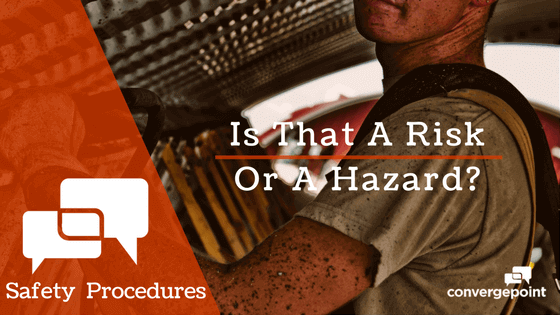Safety Procedures and Safety Training: Is that a Risk or a Hazard?

Safety Procedures and Safety Training: Is that a Risk or a Hazard?
To ask any safety professional to define a ‘hazard’ and a ‘risk’ is akin to asking a seasoned driver to differentiate between the brake and gas pedals. Duh! Cue knowing chuckles and shaking of head. Rather ask said safety professional to distinguish between strategic risk and speculative risk – at least that’s a tad trickier. There is a universal understanding in safety of what are a hazard anda risk, right? Not so fast.
OSHA defines a ‘hazard’ hence: “Any facility, location, equipment, tool, job, task, or action that presents a potential of serious injury or death to any employee.” – okay, so far, so good. Interestingly, OSHA only defines ‘risk’ within the context of medical conditions or exposure thereto and it therefore only centers on the health impact to employees. However, a generally acceptable definition for risk is usually similar to this: ‘It is the chance or likelihood of a hazard causing harm or damage to a person or to property or to the environment’.
It is contended here that the above, variations of which are often cited, is a poor definition of risk. Why the emphasis on “chance or likelihood”? What of the potential severity of said risk occurring, not to mention the potential exposure (e.g. the number of workers within the entire worker population who may be most exposed to a given risk)? Risk can be far more simply defined as the actual harm that may occur as a result of a given hazard or set of hazards.
It is during the risk assessment process itself that a poor definition becomes most problematic. By way of a simple example: take a slippery walkway. There are those risk assessors who would state the slippery walkway is the hazard. Correct. They would then contend that slipping or falling would be the risk. Incorrect. Slipping and falling are not risks – these are better defined as being the outcome of hazardous conditions. Simply put: where is the consequence? Consequence is the outcome of an event expressed qualitatively or quantitatively and that defines said event. The crux of the matter is that there may be a range of possible outcomes (consequences) associated with an event. For example, the person who slips and falls may twist an ankle. Or hit their head and die of concussion. Or simply get up and walk away with only a bruised ego. That’s three very different consequences, making for three very different risks. Honing in on the harm that may arise from the hazard will ensure a risk that is well-identified and that can be properly assessed.
The OHSAS 18001 standard (which remains unpublished as the ISO 45001 standard) defines risk as the “combination of the likelihood of an occurrence of a hazardous event or exposure and the severity of injury or ill health that can be caused by the event or exposure.” It may be a comprehensive definition of risk but it’s also unwieldy and clumsy. Far better to keep it simple: namely, hazard = the potential to cause harm, whilst risk = the actual harm that may arise.
Neither the amount (severity) of harm nor the chance (likelihood) of the harm occurring need be a part of the definition. Those evaluations are the purpose of the risk assessment process itself. A tight definition of risk keeps one focused with a risk that is crystal clear. Any person who counters the innate accuracy of the definitions proposed above is easily defied. What more is needed? Just define the risk with an appropriate consequence and the rest will follow.